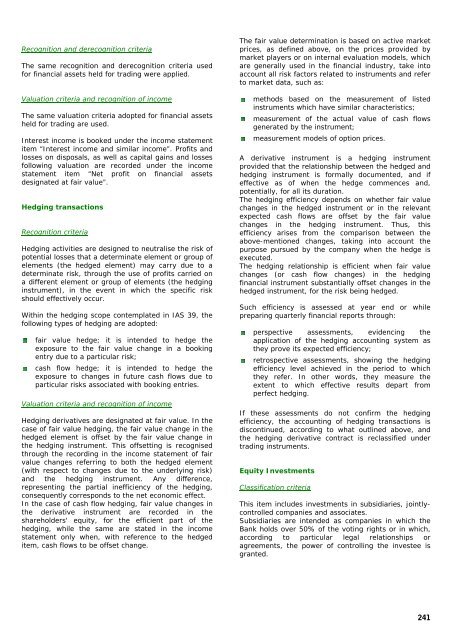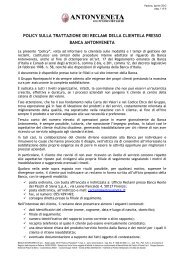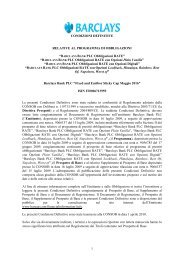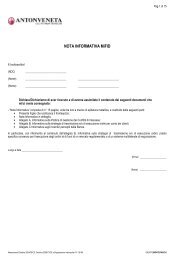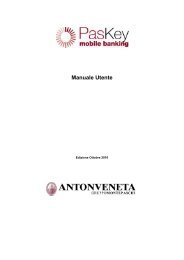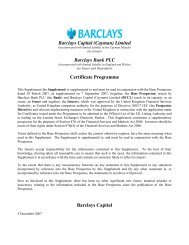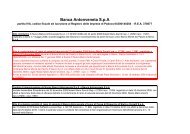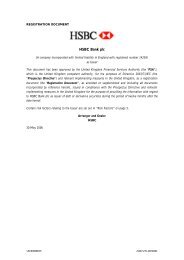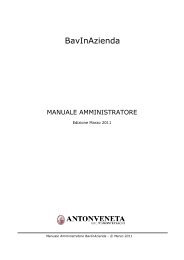996 - Banca Antonveneta
996 - Banca Antonveneta
996 - Banca Antonveneta
Create successful ePaper yourself
Turn your PDF publications into a flip-book with our unique Google optimized e-Paper software.
Recognition and derecognition criteriaThe same recognition and derecognition criteria usedfor financial assets held for trading were applied.Valuation criteria and recognition of incomeThe same valuation criteria adopted for financial assetsheld for trading are used.Interest income is booked under the income statementitem “Interest income and similar income”. Profits andlosses on disposals, as well as capital gains and lossesfollowing valuation are recorded under the incomestatement item “Net profit on financial assetsdesignated at fair value”.Hedging transactionsRecognition criteriaHedging activities are designed to neutralise the risk ofpotential losses that a determinate element or group ofelements (the hedged element) may carry due to adeterminate risk, through the use of profits carried ona different element or group of elements (the hedginginstrument), in the event in which the specific riskshould effectively occur.Within the hedging scope contemplated in IAS 39, thefollowing types of hedging are adopted:fair value hedge; it is intended to hedge theexposure to the fair value change in a bookingentry due to a particular risk;cash flow hedge; it is intended to hedge theexposure to changes in future cash flows due toparticular risks associated with booking entries.Valuation criteria and recognition of incomeHedging derivatives are designated at fair value. In thecase of fair value hedging, the fair value change in thehedged element is offset by the fair value change inthe hedging instrument. This offsetting is recognisedthrough the recording in the income statement of fairvalue changes referring to both the hedged element(with respect to changes due to the underlying risk)and the hedging instrument. Any difference,representing the partial inefficiency of the hedging,consequently corresponds to the net economic effect.In the case of cash flow hedging, fair value changes inthe derivative instrument are recorded in theshareholders' equity, for the efficient part of thehedging, while the same are stated in the incomestatement only when, with reference to the hedgeditem, cash flows to be offset change.The fair value determination is based on active marketprices, as defined above, on the prices provided bymarket players or on internal evaluation models, whichare generally used in the financial industry, take intoaccount all risk factors related to instruments and referto market data, such as:methods based on the measurement of listedinstruments which have similar characteristics;measurement of the actual value of cash flowsgenerated by the instrument;measurement models of option prices.A derivative instrument is a hedging instrumentprovided that the relationship between the hedged andhedging instrument is formally documented, and ifeffective as of when the hedge commences and,potentially, for all its duration.The hedging efficiency depends on whether fair valuechanges in the hedged instrument or in the relevantexpected cash flows are offset by the fair valuechanges in the hedging instrument. Thus, thisefficiency arises from the comparison between theabove-mentioned changes, taking into account thepurpose pursued by the company when the hedge isexecuted.The hedging relationship is efficient when fair valuechanges (or cash flow changes) in the hedgingfinancial instrument substantially offset changes in thehedged instrument, for the risk being hedged.Such efficiency is assessed at year end or whilepreparing quarterly financial reports through:perspective assessments, evidencing theapplication of the hedging accounting system asthey prove its expected efficiency;retrospective assessments, showing the hedgingefficiency level achieved in the period to whichthey refer. In other words, they measure theextent to which effective results depart fromperfect hedging.If these assessments do not confirm the hedgingefficiency, the accounting of hedging transactions isdiscontinued, according to what outlined above, andthe hedging derivative contract is reclassified undertrading instruments.Equity InvestmentsClassification criteriaThis item includes investments in subsidiaries, jointlycontrolledcompanies and associates.Subsidiaries are intended as companies in which theBank holds over 50% of the voting rights or in which,according to particular legal relationships oragreements, the power of controlling the investee isgranted.241


